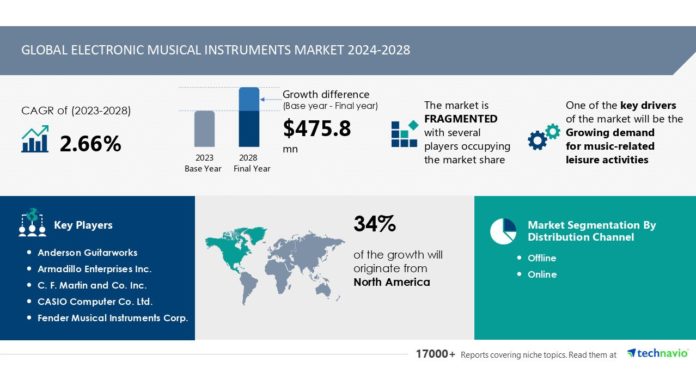The global electronic musical instruments market size is estimated to grow by USD 475.8 million from 2024-2028, according to Technavio. The market is estimated to grow at a CAGR of 2.66% during the forecast period. Growing demand for music-related leisure activities is driving market growth, with a trend towards continuous development of new musical instruments. However, increasing adoption of virtual musical instruments and music production software poses a challenge. Key market players include Anderson Guitarworks, Armadillo Enterprises Inc., C. F. Martin and Co. Inc., CASIO Computer Co. Ltd., Fender Musical Instruments Corp., Focusrite Plc, Gibson Brands Inc., inMusic Brands Inc., Kawai Musical Instruments Mfg. Co. Ltd., KORG Inc., Marshall Morrison Instruments Pty. Ltd., Music Tribe Global Brands Ltd., NS Design, Peavey Electronics Corp., Rickenbacker International Corp., Robert Bosch GmbH, Roland Corp., Shure Inc., Speck Electronics, and Yamaha Corp.
The electronic musical instruments market experiences growth due to the demand for advanced and innovative tools. Digital technology enhances sound realism and expression. Portable and affordable instruments broaden access to music learning. Integration with technology like computers and smartphones expands functionality. The rise of electronic music genres further fuels market expansion.
The Musical Instruments market includes various electronic musical instruments such as drums, microphones, keyboards, and synthesizers. These instruments are in high demand due to their versatility and ability to produce unique sounds. The trend towards digital music production has led to an increase in the use of MIDI controllers and digital audio workstations.
Additionally, the integration of artificial intelligence and machine learning in musical instruments is a growing trend. Companies are developing intelligent instruments that can learn and adapt to a musician’s playing style. The market for electronic musical instruments is expected to grow significantly in the coming years due to these trends and advancements in technology.
- The electronic musical instruments market is experiencing significant challenges due to the increasing adoption of virtual musical instruments and music production software. Developed economies are leading this trend, with music production software enabling better mobility and fewer hassles for composers.
- Popular laptop brands like Apple Inc. offer music creation tools, expanding their audience base. Mobile devices and high-speed Internet connectivity further fuel this shift, driving demand for virtual instruments through apps and websites. The sales growth of laptops and mobiles, coupled with Internet accessibility, significantly impact the electronic musical instruments market.
- The Electronic Musical Instruments market faces several challenges. Musical instruments such as digital pianos, synthesizers, drum machines, and controllers require advanced technology and components. These include microprocessors, memory, and sensors. The cost of these components can impact the price of the final product. Moreover, the market is highly competitive with numerous players offering similar products. Differentiating offerings and maintaining a competitive edge is essential. Classes, compressors, and effects processors are common features that can set products apart.
- Another challenge is keeping up with consumer trends. Musicians and producers are always looking for the latest technology and features. Staying innovative and offering unique solutions is crucial for market success. Additionally, ensuring quality and reliability is important. Electronic musical instruments must perform consistently and accurately. Ensuring durability and longevity is also a concern. Lastly, logistics and distribution can pose challenges. Ensuring timely delivery and efficient supply chain management is essential for meeting customer demands and maintaining a strong market presence. The offline segment of the global electronic musical instruments market encompasses distribution channels where instruments are sold in physical retail locations. This segment is crucial, allowing customers to test and purchase instruments in person. Key distribution channels include musical instrument stores, specializing in a wide range of electronic options, and department stores and specialty retailers, offering a selection of electronic instruments alongside other consumer goods. Direct sales from manufacturers provide a unique brand experience and personalized guidance. The preference for tactile interaction and informed purchasing continues to fuel the growth of the offline segment.
The electronic musical instruments market encompasses a wide range of innovative tools for music creation and production. Virtual musical instruments, music production software, and music synthesizers are at the forefront of this sector, enabling musicians and artists to generate unique musical sounds and compositions. The music publishing market and live performance scenes also benefit significantly from these advanced technologies.
The equipment market, including studio headphones, DJ gear, and electronic musical instruments from brands like Shure, Kawai Musical, Numark Industries, Roland, Pioneer DJ, Denon DJ, Sennheiser Electronic, Gibson Brands, and others, cater to the diverse needs of musicians and artists. Additionally, the integration of AI in musical instruments is revolutionizing the industry, offering new possibilities for musical expression. Electronic pianos and music synthesizers are essential components of this market, contributing to the electronic musical landscape with their electronic musical sounds and capabilities.
The Electronic Musical Instruments market encompasses a wide range of innovative devices used to create, perform, and record music. These instruments, such as synthesizers, drum machines, MIDI controllers, and digital audio workstations, leverage advanced technology to produce unique and diverse sounds. The market is driven by various factors, including the growing popularity of electronic music genres, increasing demand for portable and affordable instruments, and continuous technological advancements.
Additionally, the integration of these instruments with other digital platforms and the rise of music streaming services further expand their application and accessibility. Overall, the Electronic Musical Instruments market presents significant growth opportunities for manufacturers and consumers alike.







